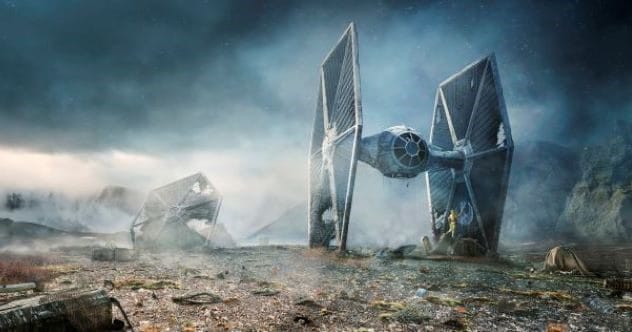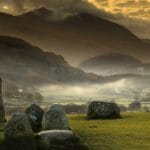When Star Wars first blasted onto screens in 1977, it felt like nothing seen before, instantly changing movies forever. But even a creation as original as Star Wars didn’t just appear from a distant galaxy. Director George Lucas gathered ideas from many places. These included history, myths, beliefs, and, importantly, other movies. Let’s dive into ten films that left a big mark on the Star Wars universe, ranging from World War II adventures and classic Westerns to Japanese masterpieces and sci-fi tales.
10. 2001: A Space Odyssey (1968)
At first glance, Star Wars and Stanley Kubrick’s 2001: A Space Odyssey seem like polar opposites. One is a thrilling space fantasy with laser battles, while the other is a thoughtful look at humanity with realistic space travel. However, Star Wars pays homage to this groundbreaking film in many ways. You can see it in its classic-style music, visual cues, and even the depiction of intelligent machines. George Lucas himself has often pointed to A Space Odyssey as a major source of inspiration. Interestingly, makeup artist Stuart Freeborn worked on both movies. He created the apes for 2001’s “The Dawn of Man” sequence and later designed the Yoda puppet for Star Wars.
9. 633 Squadron (1964)
633 Squadron is a World War II movie about a fictional Royal Air Force (RAF) squadron. Although some critics found issues with its historical accuracy when it was released, it became a beloved war film. More importantly, it deeply influenced George Lucas and his team working on Star Wars. The most visible impact is in the famous “trench run” scene at the end of A New Hope. Here, Luke Skywalker and his fellow pilots attack a weak spot on the Death Star. Lucas closely modeled this action on 633 Squadron’s finale, where bombers navigate a narrow fjord under heavy enemy fire.
8. Metropolis (1927)
Many modern sci-fi movies owe something to the 1927 German masterpiece Metropolis, and Star Wars is definitely one of them. The futuristic, towering cityscapes of Coruscant, for example, clearly draw inspiration from the art style of Metropolis’s city. Both films also explore similar themes of power struggles. But the influence of Metropolis is perhaps most striking in the design of C-3PO. While C-3PO has a masculine persona, his physical resemblance to the feminine robot Maschinenmensch from Metropolis is intentional. Conceptual designer Ralph McQuarrie, who was key in C-3PO’s design, confirmed that Maschinenmensch was a direct inspiration.
7. The Searchers (1956)
It’s widely known that Star Wars borrowed many elements from classic Westerns, including settings and plot ideas. Among these, John Ford’s 1956 film The Searchers left a particularly strong mark. The movie follows John Wayne as a Civil War veteran who teams up with his nephew to rescue his kidnapped niece. This basic plot mirrors aspects of A New Hope, as does the grand desert landscape. One of the most directly influential scenes shows Wayne’s character returning to his brother’s ranch to find it destroyed and his family massacred. This is strikingly similar to when Luke Skywalker finds his aunt and uncle’s home burned and their lives taken by stormtroopers.
6. The Wizard of Oz (1939)
Both The Wizard of Oz and Star Wars are undisputed landmarks in movie history. Ever since Star Wars first appeared, fans and critics alike have noted the connections between the two. The similarities become clearer the more you look. Both films tell the story of an adventure-seeking young person raised on a farm by their aunt and uncle. Due to events beyond their control, these protagonists leave their familiar worlds to journey through strange lands filled with unusual beings. As critic Roger Ebert pointed out, their companions are also similar: “The golden robot, lion-faced space pilot, and insecure little computer on wheels must have been suggested by the Tin Man, the Cowardly Lion, and the Scarecrow in The Wizard of Oz.” Furthermore, concept designer Ralph McQuarrie stated that Emerald City inspired Cloud City’s look in The Empire Strikes Back. The influence of The Wizard of Oz on Star Wars is truly undeniable.
5. The 7th Voyage of Sinbad (1958)
The 7th Voyage of Sinbad is significant for pioneering special effects techniques that Star Wars later utilized, like optical printing and colorized stop-motion. But its influence doesn’t stop there. Much like the original Star Wars, its story is about a quest to rescue a princess. There’s even a scene where Sinbad and a princess swing across a chasm on a rope, echoing a similar moment with Luke Skywalker and Princess Leia in A New Hope. The prequels also show this influence; Count Dooku’s morally ambiguous villainy shares traits with Sokurah the Magician from Sinbad. When Sokurah’s evil plans are revealed, he unleashes beasts upon the heroes, just as Count Dooku does at the end of Attack of the Clones. Lastly, Sinbad’s theme of showing kindness to smaller, seemingly lesser beings is a recurring element in Star Wars, notably in the alliance between the rebels and Ewoks in Return of the Jedi.
4. The Triumph of the Will (1935)
The Triumph of the Will was a controversial propaganda film made for the Nazi regime. Despite its dark origins, it became incredibly influential in cinematography. The film’s infamous aerial shots of vast formations of soldiers have inspired moments in many movies, from The Lion King to Lord of the Rings, and indeed, Star Wars. Interestingly, the first Star Wars scene to echo The Triumph of the Will presents these visuals in a positive context: the medal ceremony at the end of A New Hope, celebrating the heroes’ victory. However, later films like The Empire Strikes Back and The Force Awakens draw on similar imagery to portray the villains as an overwhelmingly powerful and fascist force.
3. Seven Samurai (1954)
While Star Wars clearly draws from Western culture, it also has deep roots in Eastern influences. The Jedi and Sith, with their robes, lightsabers, distinct mannerisms, and philosophies, show a clear nod to traditional Japanese culture. The word “Jedi” itself is thought to derive from “jidaigeki,” a Japanese genre of historical dramas, which includes many films by Akira Kurosawa, such as Seven Samurai. George Lucas has always admired Kurosawa’s work, especially Seven Samurai. He once said it “basically changed my life,” praising its mix of story, acting, humor, action, and suspense. The film is about villagers hiring seven masterless samurai (ronin) to protect them from raiders. This “Seven Samurai formula” of assembling a diverse team is evident throughout Star Wars, from the original trio to new heroes in sequels and spin-offs. Cinematographic nods to Seven Samurai also appear, like the climactic duel in Star Wars: The Last Jedi.
2. The Dam Busters (1955)
Similar to 633 Squadron, The Dam Busters is another pilot-focused war film that heavily influenced the trench run sequence in A New Hope. Directed by Michael Anderson, it recounts the true story of RAF raids on German dams during World War II. In the movie, pilots face the challenge of making a near-impossible shot to destroy these dams. This mirrors Luke Skywalker’s daunting task of hitting a small thermal exhaust port with a proton torpedo. Lucas even lifted dialogue almost word-for-word from The Dam Busters. For instance, a line where a pilot asks, “How many guns do you think, Trevor?” and gets the reply, “I’d say there’s about ten guns. Some in the field, some on the tower!” is very similar to dialogue in Star Wars. The connection is even stronger considering A New Hope’s cinematographer, Gilbert Taylor, worked on special effects for The Dam Busters, and makeup artist Stuart Freeborn also contributed to both films.
1. The Hidden Fortress (1958)
Akira Kurosawa’s The Hidden Fortress is another Japanese film whose influence on Star Wars is perhaps even more direct than Seven Samurai. The character parallels are striking. Both movies feature a strong-willed princess leading a rebellion after her kingdom is destroyed. The character arc of General Rokurōta Makabe in The Hidden Fortress closely resembles that of Obi-Wan Kenobi in A New Hope. Both are initially dismissed as old men but prove their skill in a duel with an old rival, allowing their allies to escape. In both films, the story is often seen through the eyes of two less prominent, “lower-class” characters. In The Hidden Fortress, these are two bickering peasants; in Star Wars, they are droids. These overlooked characters often save the day unintentionally. There’s also a character, General Hyoe Tadokoro, who undergoes a redemption arc similar to Darth Vader’s in Return of the Jedi. Additionally, both The Hidden Fortress and several Star Wars films feature a powerful villain operating from off-screen. Beyond story and characters, Star Wars also borrows cinematographic style from The Hidden Fortress, such as the use of wipe transitions between scenes and similarities in musical scores.
From epic space battles to the very fabric of its characters and themes, Star Wars owes a considerable debt to these cinematic predecessors. George Lucas masterfully wove together these diverse influences, creating something new yet deeply resonant with film history.
What other films do you think influenced Star Wars? Leave your comment below!










